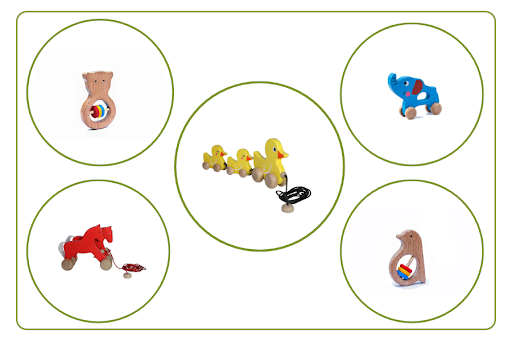You walk into any baby shop and your eyes drown in a release of bright plastic toys, flashing lights, and cute little songs. But somewhere in the middle is a shelf with something a little quieter, stronger, and strangely nostalgic – wooden baby toys. While those wooden toys don’t have lights or sounds, they have something even better: they are safe, simple, and sustainable.
For new parents, making the right choice can be tough, it’s nice to know, wooden toys are as much adorable as they are often the simply better choice.
The Safety Factor: Why Wood Wins
Babies explore the world using their hands, mouths, and sometimes even their tiny toes. So it’s completely appropriate that the toys we choose for our babies be made from materials we trust. With that in mind, wooden baby toys are great for this purpose:
- Non-toxic & chemical-free: Quality wooden baby toys, in general, are made without harsh chemicals, unlike poorly sourced plastic toys that may contain B.P.A. or phthalates. Quality wooden baby toys are often finished with food grade oils or dyes, so you should never have to worry about your baby sucking on a toy and getting something harmful in their mouth (which they are going to do).
- No small detachable pieces: Most wooden baby toys are made in one piece (solid shaped) or have parts that were put together to stay together, greatly minimizing the chance of choking.
- Durable & smooth: Wooden surfaces can be strong, but they can be so smooth when well-sanded. You can count on them not to shatter into sharp pieces like nasty brittle plastic.
In summary, wooden baby toys give you confidence that when babies are playing, they are safe.
How Wooden Toys Help The Environment
Choosing eco-friendly toys isn’t just a trend. Here’s how wooden baby toys help:
- Safe and green: Wood is a renewable resource when sustainably harvested. Wood breaks down naturally into the soil, and unlike plastic, it does so in a couple of years instead of hundreds of years!
- Less toxic manufacturing: Most wooden baby toys are made using less chemicals and manufacturing waste. This all adds up to less pollution in the soil, air, and water when producing toys.
- Less time wasting: Less toys going to the rubbish heaps over time because wooden baby toys last longer and break less, more toys you can pass on or give reuse (even siblings or future siblings!).
One small choice can potentially create a large impact.
Designed For Imagination, Not Overstimulation
Modern toys often aim to “do more”, flashing lights, electronic music, or interactive buttons. While that may seem exciting, it can sometimes overwhelm babies who are still learning to process sounds and sights.
Wooden baby toys do the opposite:
They invite open-ended play, the kind that builds imagination, focus, and curiosity.
For example:
- A simple wooden car encourages your baby to push, roll, and imagine a journey.
- Stacking blocks teaches balance and problem-solving.
- Wooden animal figures can become friends, characters, or part of a story your baby creates.
This kind of play supports deeper brain development without constant stimulation. Sometimes, less really is more.
Made To Last Through Every Stage
The best toys are the ones that stay useful over time. Wooden baby toys often fall into this category.
A wooden rattle might first be used for teething, then later for sensory play. Stacking rings might become part of a pretend game when your child is older. Unlike most plastic toys that have a short “age range,” wooden ones are open-ended and adaptable.
Even swing toys for babies made of wood provide gentle motion, motor skill development, and can be used indoors or outdoors, all while being safe and environmentally conscious.
A Gentle Return To Classic Play
There’s something timeless about wooden baby toys. They remind many of us of our own childhoods, before screens and electronics took over playtime.
Giving your baby wooden toys isn’t just about safety or the planet. It’s about creating a quieter, calmer kind of play. A space where imagination leads, where the toys don’t beep, and where learning happens in the simplest ways.
What To Look For When Buying Wooden Toys
Not all wooden toys are created equal. Here’s a quick checklist to help:
| Feature | Why It Matters |
| Smooth finish | Prevents splinters and feels good to touch |
| Non-toxic paint or dyes | Safe for mouthing and chewing |
| Certified wood | Ensures sustainable sourcing |
| Sturdy construction | Lasts longer and doesn’t break easily |
| Age-appropriate design | No small parts or choking hazards |
If you’re looking to start small, begin with teething rings, stacking blocks, or a simple wooden swing toy, items that combine sensory benefits with safety.
Final Thoughts: A Toy You Can Trust
Selecting toys for your child is about more than just play; it’s about providing a secure, caring environment in which they can develop, explore, and feel safe. The quiet confidence is brought about by wooden toys. Carefully crafted, devoid of harsh materials, they are designed to withstand all the drops, tosses, and teething.
They are not only safe, but they are purposeful, environmentally friendly, and build purposeful play. Whether you have a rattle for their first toy or simply a swing toy for babies, wooden toys are a calm and natural way to promote your child’s development.
Check out Tinytyke’s wooden baby toys, thoughtfully designed to nurture curiosity and bring peace of mind with every gentle sway.

